Discover top UML diagram software in 2025 to design clear, collaborative, and effective diagrams effortlessly. Capture ideas with ease and precision.
Clear communication is crucial for successful software projects. UML diagram software solves this by providing visual representations of system architecture and design. This list of top 10 UML diagram software tools for 2025 will help you choose the right solution for your needs. Whether you’re a freelancer or part of a large team, the right UML diagram software improves collaboration and reduces errors. From DocuWriter.ai to Modelio, we’ll explore key features, pros, and cons of each platform, empowering you to make an informed decision and optimize your software design process.
DocuWriter.ai presents itself as a revolutionary solution for developers seeking to streamline their documentation process. Leveraging AI, it automates the generation of code and API documentation, promising significant time savings and improved consistency. This platform goes beyond basic documentation by offering features like UML diagram generation, code refactoring, test suite generation, and code language conversion. This makes it a potentially valuable tool for a wide range of users, from freelancers to enterprise-level teams. Its focus on automation and comprehensive feature set positions it as a strong contender in the realm of UML diagram software and overall code management. The claim of saving thousands of hours for its existing user base certainly piques interest, suggesting a potential for considerable productivity gains.
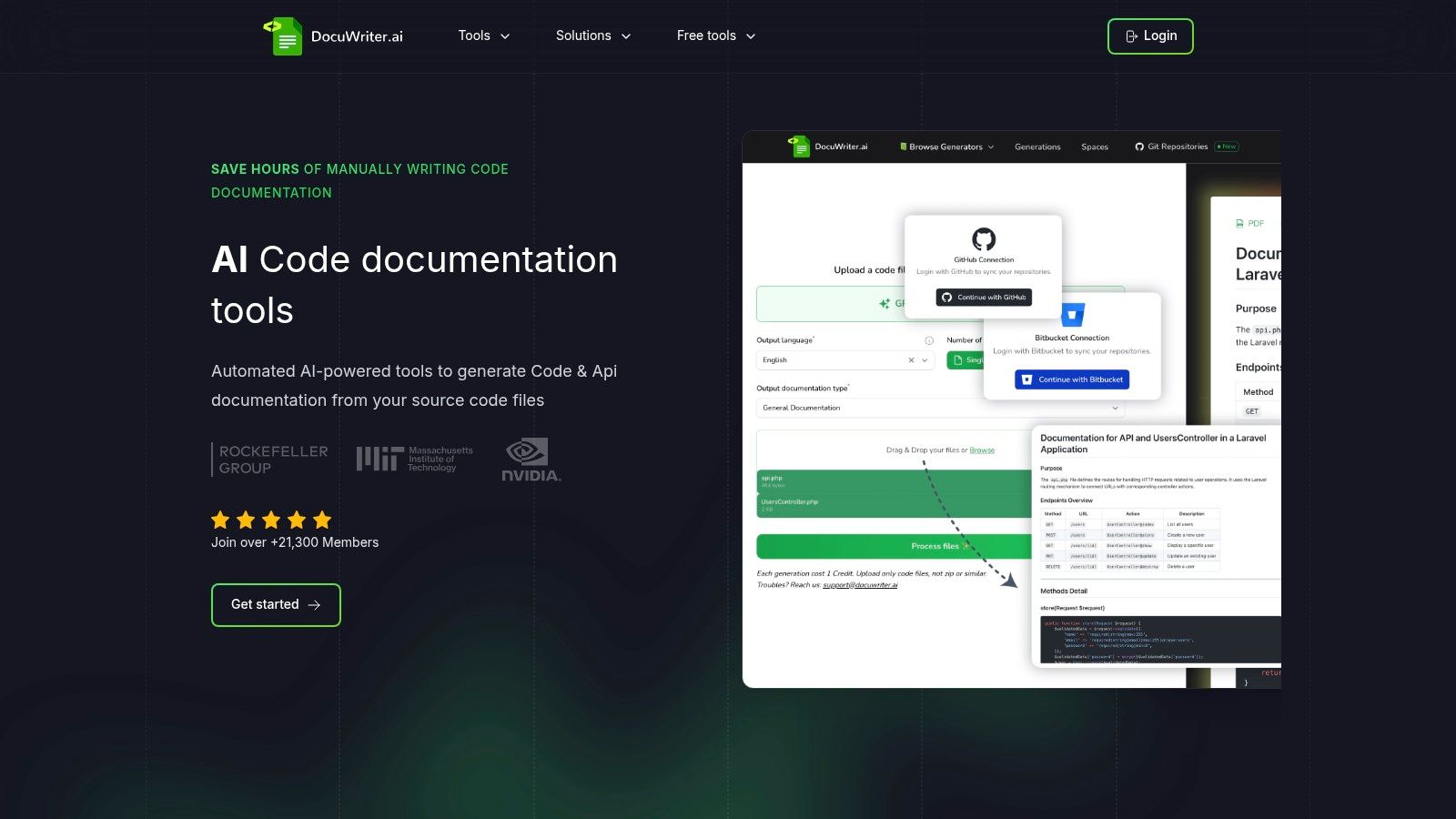
The value proposition of DocuWriter.ai lies in its automation capabilities. Imagine a scenario where a developer updates a complex piece of code. Manually updating the corresponding documentation can be tedious and error-prone. DocuWriter.ai aims to eliminate this manual effort by automatically generating updated documentation, reflecting the changes in the code. This not only saves time but also ensures that the documentation remains synchronized with the codebase, reducing the risk of discrepancies and outdated information. Furthermore, the consistency offered by automated generation is crucial for maintaining professional standards and improving code readability across projects, especially within larger teams.
For software engineers working on UML diagrams, DocuWriter.ai offers a streamlined approach. Instead of manually creating and updating diagrams in separate tools, developers can potentially generate UML diagrams directly from their code. This integration simplifies the workflow and ensures the diagrams accurately represent the code structure. This feature is particularly relevant for agile development environments where frequent changes necessitate constant diagram updates. The ability to visualize code structure through automatically generated UML diagrams can be instrumental in understanding complex systems, facilitating communication within development teams, and aiding in the design and architectural planning of software projects.
While the breadth of features is impressive, the lack of a clearly advertised free trial or free tier is a notable drawback. This makes it difficult for potential users to thoroughly evaluate the software before committing to a paid subscription. A free trial period or a limited-feature free tier would significantly lower the barrier to entry and allow users to experience the core functionality firsthand.
Another point to consider is that some advanced features, like git repository integrations and team-based role management, appear to be reserved for higher-tier subscription plans. While this tiered approach is common in SaaS products, it’s important for potential users to carefully evaluate their needs and choose a plan that aligns with their requirements. Smaller teams or freelancers might find the entry-level plan sufficient, while larger enterprises with complex workflows might benefit from the advanced features offered in the higher-tier plans.
DocuWriter.ai promotes flexible subscription plans starting at $19/year, making it accessible to individual developers and small teams. The availability of educational discounts further enhances its appeal to students and educational institutions. This pricing strategy, combined with the potential for significant time savings, could make DocuWriter.ai a cost-effective solution for managing documentation and generating UML diagrams.
In terms of setup and implementation, the platform boasts integrations with popular tools like VSCode and Zapier. VSCode integration allows developers to work within their preferred coding environment, streamlining the documentation workflow. Zapier integration opens up possibilities for automating tasks and connecting DocuWriter.ai with other applications in a developer’s toolchain. However, specific technical requirements for using the software are not readily available on the website and would benefit from clearer documentation.
Compared to standalone UML diagram tools, DocuWriter.ai’s integrated approach offers a distinct advantage. By combining UML diagram generation with code documentation and other code management features, it provides a more holistic solution. This integration can potentially reduce context switching between different tools and create a more efficient workflow.
DocuWriter.ai’s claimed community of over 21,300 users and the reported time savings suggest that it has gained traction among developers. However, independent reviews and comparisons with similar tools are necessary for a more comprehensive evaluation.
In conclusion, DocuWriter.ai offers a compelling proposition for developers and engineers looking to automate their documentation and UML diagram generation processes. Its AI-powered features, comprehensive feature set, and competitive pricing make it a tool worth considering. However, the absence of a clearly defined free trial and the tiered feature availability are factors that potential users should carefully consider. A more transparent approach to pricing and feature details would strengthen its value proposition and encourage wider adoption. Website: https://www.docuwriter.ai/
Lucidchart stands out as a leading web-based UML diagram software, offering a robust suite of tools for creating professional, collaborative diagrams. Its intuitive drag-and-drop interface combined with a rich library of UML shapes and templates makes it accessible to both beginners and experienced users. Whether you’re a software developer mapping out system architecture, a startup visualizing product workflows, or an engineering team collaborating on complex designs, Lucidchart provides the features and flexibility needed to effectively communicate through UML diagrams. Its strength lies in simplifying the process of UML diagramming, enabling users to focus on design and analysis rather than grappling with complex software. This ease of use, coupled with its comprehensive collaboration features, solidifies its position as a top contender in the UML diagram software landscape.
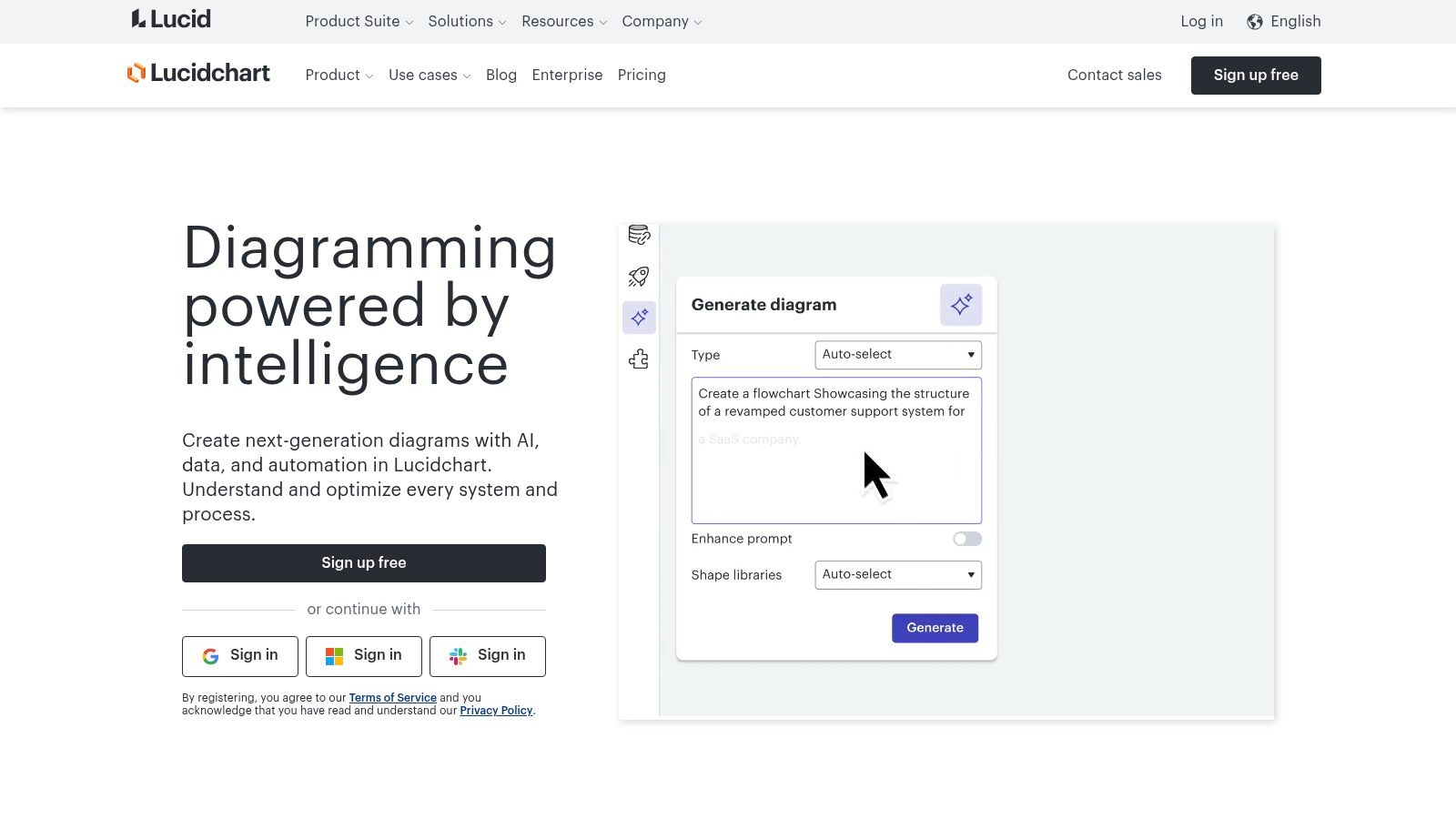
Lucidchart’s comprehensive shape libraries cover a wide range of UML diagram types, from class diagrams and sequence diagrams to use case diagrams, activity diagrams, and state diagrams. This breadth of coverage makes it suitable for various software development methodologies and project complexities. The auto-layout and smart formatting features further enhance the user experience by automatically organizing diagram elements and maintaining a clean, professional look. This is particularly beneficial for larger, more intricate diagrams, saving users significant time and effort.
One of Lucidchart’s key strengths is its focus on collaboration. Real-time co-authoring allows multiple team members to work on the same diagram simultaneously, fostering seamless communication and efficient workflows. Integrated commenting and feedback features facilitate direct communication within the platform, streamlining the review and iteration process. This collaborative environment makes Lucidchart particularly well-suited for agile development teams and projects requiring rapid prototyping and iterative design.
Lucidchart integrates seamlessly with popular platforms like Confluence, Jira, and Google Workspace. This integration allows users to embed UML diagrams directly into project documentation, wikis, and other collaborative workspaces, enhancing communication and knowledge sharing. For example, developers can link their UML diagrams in Jira tickets to provide visual context for bug reports or feature requests. Similarly, product managers can embed use case diagrams in Confluence pages to clearly define product requirements.
While Lucidchart offers a free limited version, its full potential is unlocked through its subscription-based pricing plans. These plans offer varying levels of features and document storage, catering to individual users, teams, and enterprises. Potential users should carefully evaluate the features offered in each tier to ensure it aligns with their specific needs and budget. While the cost can be a barrier for individual users, the collaborative features and integrations make it a valuable investment for teams and organizations.
Regarding technical requirements, Lucidchart being web-based eliminates the need for complex installations or specific operating systems. It is accessible from any device with a web browser, providing flexibility and convenience for users working remotely or across different devices. However, offline functionality is limited, which can be a drawback in situations with unreliable internet connectivity. While Lucidchart provides some offline viewing capabilities, editing and collaboration require an active internet connection.
For getting started with Lucidchart, users can leverage the extensive template library and readily available tutorials. The platform provides a gentle learning curve, making it easy for even beginners to create basic UML diagrams quickly. As users become more familiar with the interface, they can explore advanced features like custom shape libraries and conditional formatting to create more complex and specialized UML diagrams. It’s recommended to start with a simple diagram and gradually explore the more advanced functionalities as needed.
In comparison to other UML diagram software, Lucidchart excels in its user-friendly interface and collaborative features. While tools like Draw.io offer open-source alternatives, they often lack the seamless integration and polished user experience found in Lucidchart. For users prioritizing ease of use, real-time collaboration, and a robust integration ecosystem, Lucidchart presents a compelling option. However, users on a tight budget or requiring advanced offline capabilities should consider exploring alternative solutions.
Visual Paradigm stands out as a robust and comprehensive UML diagram software solution, catering to a diverse range of users from individual developers to large enterprise teams. Its strength lies in its full-fledged support for the entire spectrum of UML 2.x diagrams, combined with advanced features for code engineering, database design, and business process modeling. This makes it a powerful tool for software development projects of all sizes and complexities. Whether you are designing a complex software architecture, mapping out business workflows, or simply visualizing system interactions, Visual Paradigm provides a rich feature set to meet your needs. This breadth of functionality justifies its inclusion in this list of top UML diagram software.
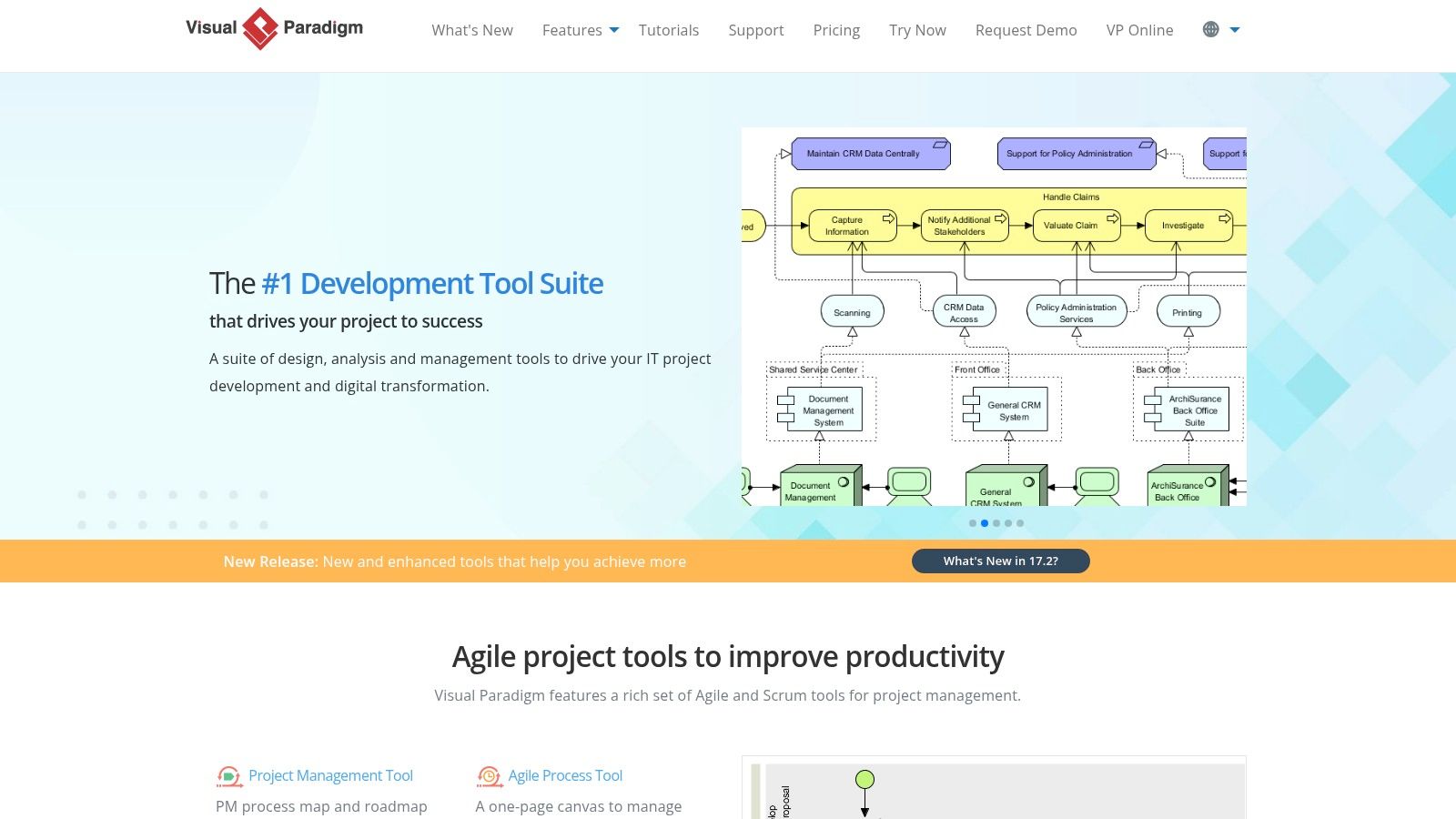
One of the key advantages of Visual Paradigm is its comprehensive support for all 14 UML 2.x diagram types. This includes class diagrams, use case diagrams, sequence diagrams, activity diagrams, state machine diagrams, and more. This complete coverage ensures that developers can model every aspect of their software systems, from high-level architectural views down to detailed behavioral descriptions. This contrasts with some other UML diagram software which may only offer a limited subset of diagram types, forcing users to adopt multiple tools for different modeling tasks.
Furthermore, Visual Paradigm goes beyond simple diagramming. It offers robust code engineering capabilities, allowing developers to generate code from their UML diagrams and reverse engineer existing code into diagrams. This bidirectional code engineering feature supports multiple programming languages, including Java, C++, Python, and C#, facilitating a seamless transition between design and implementation. This tight integration between model and code is particularly valuable for Agile development methodologies, enabling teams to maintain consistency and reduce errors.
For teams working on complex projects, Visual Paradigm provides integrated project management and collaboration tools. These features enable team members to work concurrently on the same model, track changes, and manage different versions of the diagrams. This collaborative environment streamlines the design process and improves communication within the team, making it particularly beneficial for distributed teams. Other similar tools often lack these integrated project management features, requiring users to rely on external project management software.
Beyond software development, Visual Paradigm also caters to business process modeling. Its support for BPMN and other business modeling notations allows users to visualize and analyze business processes, identify bottlenecks, and optimize workflows. This makes it a versatile tool for both technical and business users, fostering better communication and alignment between IT and business stakeholders.
While Visual Paradigm offers a powerful and feature-rich environment, it is worth noting some potential drawbacks. The software can have a steep learning curve for beginners due to the sheer number of features and the complexity of the interface. New users may find themselves overwhelmed initially and require some time to become proficient with the tool. Additionally, the full feature set comes at a higher price point compared to some other UML diagram software options, making it potentially less accessible for individuals or small teams with limited budgets.
Visual Paradigm offers several pricing tiers depending on the features and usage required. The Modeler Edition, suitable for individual users and small teams, starts at a lower price point. For larger teams and enterprise deployments, the Enterprise Edition provides advanced features like team collaboration and code engineering, but comes with a higher cost. A free trial is available, allowing users to explore the software and its features before committing to a purchase. Technical requirements vary depending on the chosen deployment option (cloud or desktop), but generally require a modern operating system and sufficient memory. Detailed system requirements are available on the Visual Paradigm website.
For those seeking a comprehensive and powerful UML diagram software solution with advanced code engineering and team collaboration features, Visual Paradigm is a strong contender. Despite its complexity and higher price point, its extensive capabilities and professional-grade features justify its place on this list. It’s particularly well-suited for professional developers, enterprise teams, and those working on complex software development projects. You can explore more about Visual Paradigm and its features on their official website: https://www.visual-paradigm.com.
Diagrams.net (formerly draw.io) stands out as a robust and entirely free, open-source UML diagram software solution, making it an invaluable tool for a broad spectrum of users, from students and freelancers to startups and established engineering teams. Its accessibility through any web browser eliminates the need for downloads or installations, facilitating quick and easy UML diagram creation. This, combined with its no-cost structure, positions diagrams.net as a compelling alternative to premium, subscription-based UML diagram software. It empowers users to visualize software architecture, design patterns, and system interactions without incurring any financial overhead. This affordability is particularly beneficial for budget-conscious individuals, small businesses, and educational institutions seeking effective UML diagramming capabilities.
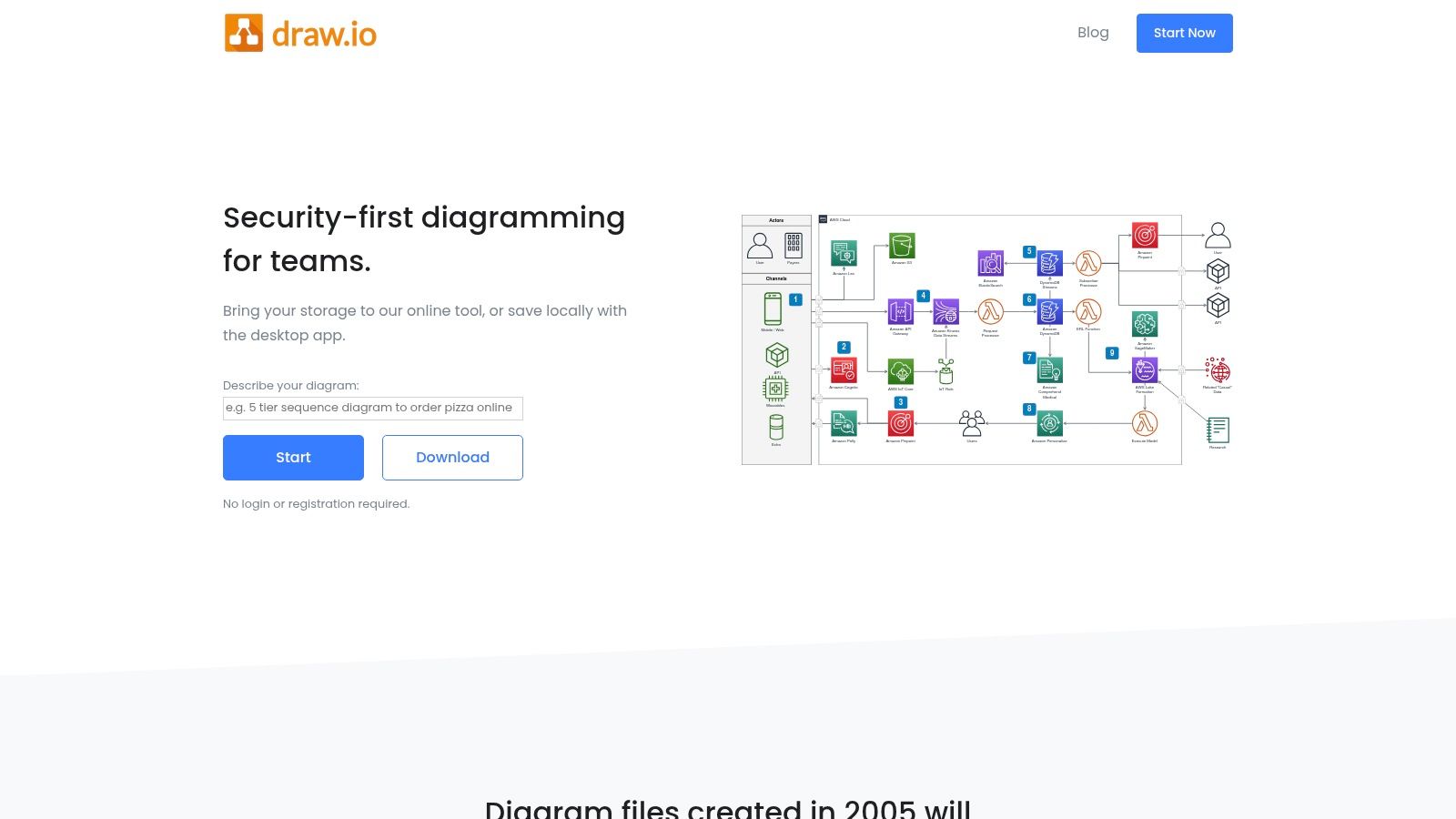
One of the most compelling aspects of diagrams.net is its complete freedom from registration requirements. Users can access the full functionality of the tool without creating an account, preserving privacy and streamlining the diagramming process. This frictionless experience is a significant advantage for users who need to quickly generate UML diagrams without administrative hurdles. Furthermore, diagrams.net offers both online and offline functionality. While the web-based version offers convenience and accessibility, the offline desktop versions cater to users working in environments with limited or no internet connectivity. This flexibility ensures uninterrupted workflow regardless of location or network availability.
Diagrams.net supports all major UML diagram types, including class diagrams, use case diagrams, sequence diagrams, activity diagrams, and deployment diagrams. This comprehensive support allows users to model various aspects of software systems throughout the entire software development lifecycle. Whether it’s defining system requirements with use cases, designing class structures, or visualizing system deployments, diagrams.net provides the necessary tools. Learn more about draw.io (now diagrams.net) and its capabilities.
While diagrams.net offers a robust set of features for free, it’s essential to acknowledge some limitations, particularly when compared to premium UML diagram software. Advanced features like code generation, model validation, and real-time collaboration are not available in the free version. The user interface, while functional, is relatively basic compared to some paid alternatives. This might present a steeper learning curve for users accustomed to more visually polished and feature-rich interfaces. However, the extensive library of UML templates provided by diagrams.net significantly mitigates this by offering pre-designed starting points for various UML diagrams.
For users seeking a free and readily accessible UML diagramming tool, diagrams.net excels. Its cross-platform compatibility, offline functionality, and support for all major UML diagram types make it a valuable resource for a wide range of users. Integration with cloud storage services like Google Drive, OneDrive, and GitHub allows for seamless file storage and sharing, enhancing collaborative workflows. Exporting diagrams in various formats, including PNG, SVG, and PDF, ensures compatibility and portability across different platforms and applications.
While the lack of advanced features and real-time collaboration in the free version might be a drawback for some users, the core functionality and cost-effectiveness of diagrams.net make it an excellent choice for those prioritizing a free, accessible, and readily available UML diagramming solution. Its simplicity, combined with its comprehensive UML diagram support, makes it a powerful tool for visualizing software systems and effectively communicating design ideas. The software is ideal for software developers, engineers, tech startups, and anyone needing to create professional UML diagrams without the cost barrier of premium software. Its easy-to-use interface and wide array of features make it suitable for both beginners and experienced users alike. Visit the diagrams.net website to explore its functionalities and experience its capabilities firsthand.
Enterprise Architect, developed by Sparx Systems, stands out as a robust and comprehensive UML diagram software solution specifically tailored for large-scale software development projects and intricate system architecture design. Its extensive feature set goes far beyond basic UML diagramming, encompassing requirements management, team collaboration tools, and robust code generation capabilities, solidifying its position as a powerful tool for enterprise-level software development. This makes it a strong contender for teams needing powerful modeling and management within their development lifecycle.
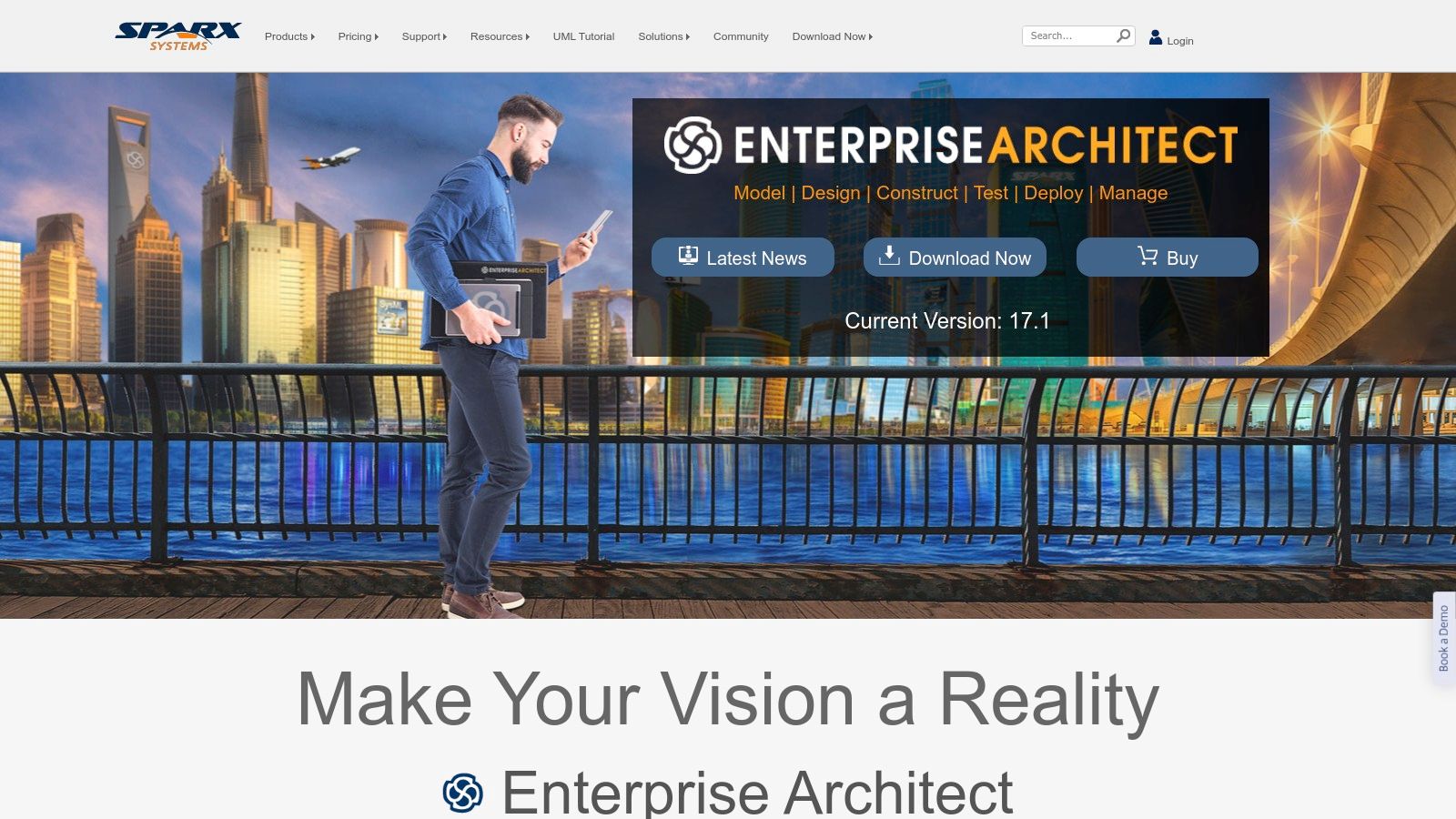
Enterprise Architect shines in complex projects due to its full compliance with UML 2.5, offering a wide array of diagram types including class diagrams, sequence diagrams, use case diagrams, activity diagrams, and deployment diagrams. This allows teams to visualize and model every aspect of their software architecture with precision. Beyond just diagramming, its integrated requirements management functionality enables seamless traceability from initial requirements through to design, implementation, and testing, ensuring alignment and facilitating efficient change management. This level of traceability is crucial for regulated industries and complex projects where adhering to initial requirements is paramount. For teams employing agile methodologies, this traceability provides a clear link between user stories and the resulting implementation, improving transparency and collaboration.
The multi-user repository with built-in version control capabilities facilitates efficient team collaboration, enabling multiple users to work concurrently on the same project while maintaining data integrity. This feature becomes essential in distributed teams or large organizations where concurrent access and version control are non-negotiable. Furthermore, Enterprise Architect’s code generation support for over 10 programming languages, including Java, C++, C#, and Python, streamlines the development process by automating the creation of code skeletons from UML models. This automation reduces manual coding effort and ensures consistency between design and implementation.
One of the strongest arguments for Enterprise Architect is its robust simulation and model validation tools. These capabilities allow developers to test and validate their designs before implementation, identifying potential issues early in the development lifecycle and reducing the cost of fixing errors later. This proactive approach to quality assurance is crucial for mission-critical systems where reliability and stability are of utmost importance.
While Enterprise Architect offers a comprehensive suite of powerful features, it is important to acknowledge its potential drawbacks. The software’s steep learning curve and complex interface can be intimidating for new users or those unfamiliar with UML modeling. Effective utilization requires significant investment in training and familiarization. Additionally, Enterprise Architect’s licensing costs can be substantial, making it a significant investment, especially for smaller businesses or individual developers. For those with simple UML diagramming needs, the extensive feature set might be overkill, and more lightweight, cost-effective alternatives could be considered. Finally, Enterprise Architect is primarily Windows-centric, with limited cross-platform support, potentially posing compatibility challenges for teams using other operating systems.
Pricing: Enterprise Architect offers a tiered licensing model based on user needs and functionality, ranging from the Professional edition for individual users to the Ultimate edition with advanced features for enterprise-level deployments. Specific pricing details are available on the Sparx Systems website.
Technical Requirements: Enterprise Architect primarily runs on Windows operating systems. While there is a limited version for Linux using Wine, full cross-platform support is not available. Hardware requirements depend on the complexity of the models and the size of the team, but a reasonably modern system with adequate RAM and processing power is recommended.
Comparison with Similar Tools: Compared to tools like Lucidchart or Draw.io, which are focused on general-purpose diagramming, Enterprise Architect is distinctly geared towards professional software development and system architecture. While tools like StarUML offer UML modeling capabilities, Enterprise Architect differentiates itself through its extensive requirements management, team collaboration, and code generation features.
Implementation/Setup Tips: Implementing Enterprise Architect effectively in a team environment necessitates a structured approach. Start with a pilot project to familiarize the team with the software and its features. Develop clear modeling conventions and guidelines to ensure consistency across the project. Leverage the multi-user repository and version control capabilities from the outset to facilitate collaborative modeling.
For software developers, engineers, and architects working on complex projects, Enterprise Architect provides the depth and breadth of functionality necessary to manage the entire software development lifecycle. Its comprehensive features, albeit with a learning curve and a cost, make it a powerful tool for UML diagram software needs within enterprise-scale projects. For more information and to download a trial version, visit the Sparx Systems website: https://sparxsystems.com
PlantUML stands out in the crowded field of UML diagram software by offering a unique text-based approach to diagram creation. Instead of relying on drag-and-drop interfaces, PlantUML leverages a simple, human-readable syntax to define UML diagrams. This programmatic approach to UML diagramming makes it particularly well-suited for developers who prefer working with code and integrating diagrams directly into their development workflows. This tool allows for a more efficient and version-control-friendly method of managing UML diagrams within projects, making it an excellent choice for software engineers, tech startups, and anyone involved in software development. PlantUML empowers developers to create and manage UML diagrams as code, promoting consistency and collaboration within engineering teams.
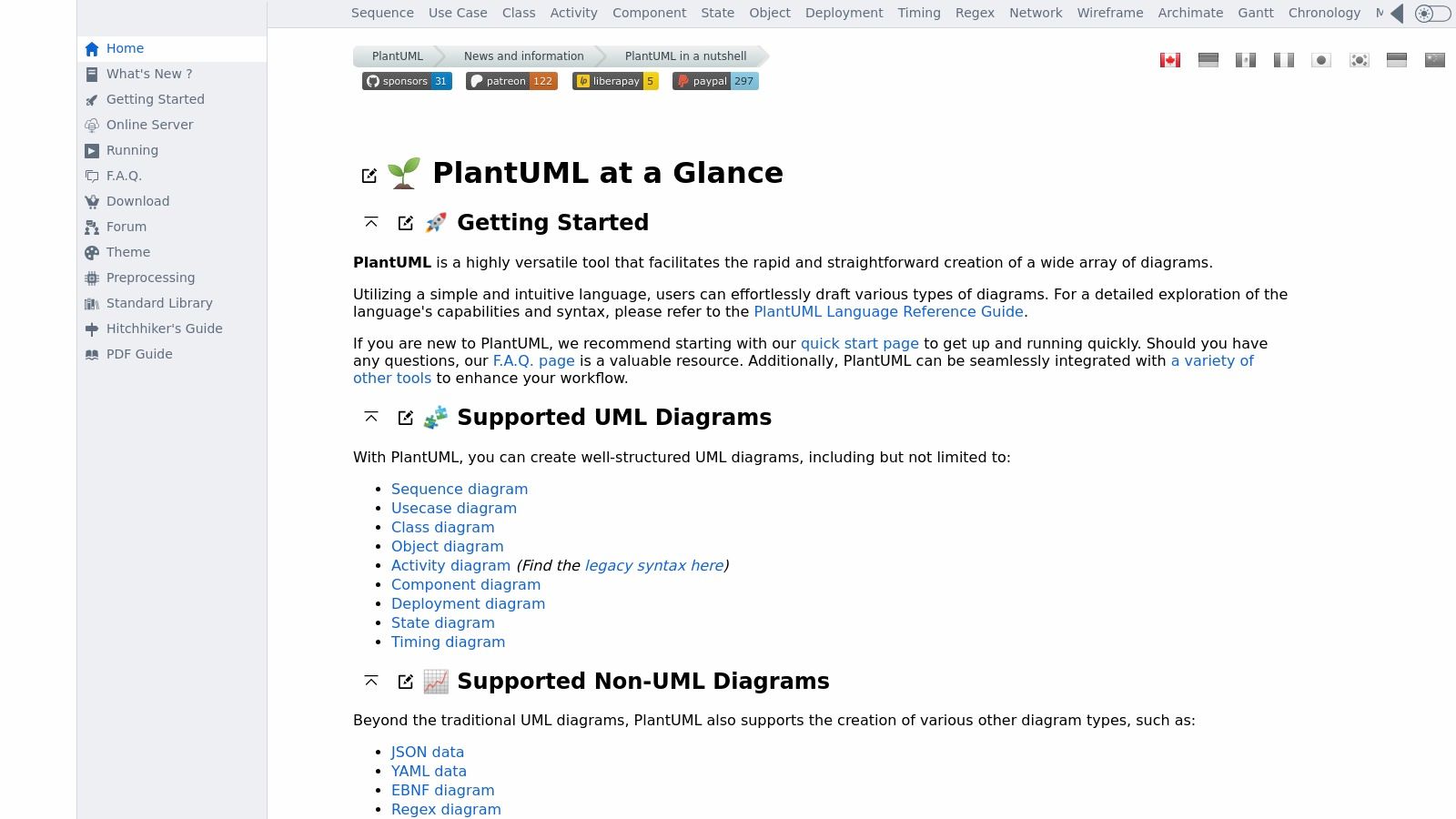
One of PlantUML’s key strengths is its support for a wide range of UML diagram types, including class diagrams, sequence diagrams, use case diagrams, activity diagrams, component diagrams, state diagrams, and deployment diagrams. This broad compatibility ensures that PlantUML can cater to diverse diagramming needs across various software development projects. Whether you’re visualizing system architecture, modeling user interactions, or documenting system deployments, PlantUML provides the necessary tools to generate appropriate UML diagrams. This versatility makes PlantUML a valuable asset for software developers, web developers, app developers, and DevOps teams alike.
PlantUML excels in its integration capabilities. It seamlessly integrates with various Integrated Development Environments (IDEs), wikis, and documentation tools. This allows developers to embed UML diagrams directly into their code repositories, documentation pages, and collaborative workspaces. Such tight integration streamlines the development workflow and ensures that UML diagrams remain consistent with the evolving codebase. This is particularly beneficial for engineering teams practicing agile development methodologies, where continuous integration and documentation are crucial. You can learn more about PlantUML and its code-to-diagram capabilities in our related article.
Being free and open-source, PlantUML removes any financial barriers to entry, making it accessible to individual developers, freelancers, and small business owners. This open-source nature also fosters community support and contributions, ensuring the ongoing development and improvement of the tool.
While the text-based approach offers numerous advantages, it also presents a learning curve. Users need to familiarize themselves with the specific PlantUML syntax to effectively create diagrams. This can be initially challenging for non-technical users or those accustomed to visual diagramming tools. Furthermore, the visual editing capabilities of PlantUML are limited compared to graphical UML diagram software. Direct manipulation of diagram elements is not possible, and styling and customization options are basic. Therefore, PlantUML might not be the ideal choice for users who prioritize visual aesthetics or require advanced styling features.
PlantUML’s strength lies in its ability to generate diagrams programmatically, making it highly suitable for version control and automation. The text-based format of PlantUML diagrams allows them to be easily tracked and managed within version control systems like Git. This ensures a clear history of diagram changes and facilitates collaboration among team members. Additionally, the command-line interface and API access provided by PlantUML open up opportunities for automating diagram generation and integration with other development tools. This is invaluable for DevOps teams and those seeking to implement continuous integration and delivery pipelines.
PlantUML represents a powerful and efficient approach to UML diagramming, particularly for developers who value a code-centric workflow. Its text-based syntax, extensive UML diagram support, integration capabilities, and open-source nature make it a valuable tool for software development projects of all sizes. While the learning curve associated with the syntax and limited visual editing capabilities may pose challenges for some users, the benefits of version control, automation, and seamless integration make PlantUML a compelling choice for many developers and engineering teams. This particular UML diagram software deserves its place on this list for its innovative approach to diagram creation and its focus on integrating with modern development practices. Its availability through a command-line interface and via API access further expands its usability for various scenarios including automated documentation generation and integration with CI/CD pipelines.
Creately positions itself as a collaborative diagramming platform well-suited for UML diagram creation. It aims to bridge the gap between ease of use and robust functionality, making it an attractive option for both technical users like software developers and less technical stakeholders involved in software design projects. This balance is crucial for effective communication and collaboration within development teams, making Creately a valuable tool for visualizing and refining software architecture. Its focus on collaborative features caters specifically to the needs of modern, distributed teams, allowing for seamless real-time interaction on UML diagrams.
Creately’s strength lies in its intuitive interface, simplifying the process of creating various UML diagrams, including class diagrams, sequence diagrams, use case diagrams, and activity diagrams. This user-friendliness lowers the barrier to entry for non-technical team members, allowing them to actively participate in the design process. While it excels in facilitating collaborative design with features like real-time editing and commenting, it’s important to acknowledge that Creately may not be as feature-rich as some dedicated UML modeling tools when it comes to advanced functionalities.
For software developers, Creately offers a practical way to visually represent system architecture, document design decisions, and communicate complex concepts within the team. The pre-built UML templates and shape libraries accelerate the diagramming process, freeing up developers to focus on the design itself rather than the mechanics of creating the diagram. This efficiency boost is particularly beneficial for agile development teams working on tight deadlines. Startups and small business owners can leverage Creately to effectively plan and document their software projects without requiring extensive training or specialized knowledge in UML modeling. The platform’s intuitive interface and collaborative features enable streamlined communication and ensure everyone is on the same page, regardless of their technical background.
Creately’s integration with project management tools further enhances its utility in a professional setting. This integration allows for seamless workflow management, as UML diagrams can be linked to project tasks and milestones. The ability to export diagrams in various formats facilitates sharing and presentation, making it easier to communicate design decisions to clients or stakeholders outside the development team. While Creately offers several integrations, it’s worth noting that the range of integrations might be less extensive than some of its competitors. This is a factor to consider if seamless integration with a specific project management or development tool is a critical requirement.
The platform also supports mind mapping and brainstorming functionalities, extending its use beyond strict UML diagramming. This makes Creately a versatile tool for initial project planning and ideation. Teams can use mind maps to explore different design approaches and then seamlessly transition to creating formal UML diagrams as the project progresses.
In terms of pricing, Creately offers a tiered subscription model, with options catering to individual users, teams, and enterprises. The reasonable pricing structure makes it an accessible option for smaller businesses and startups. However, it is crucial to review the specific pricing plans to ensure they align with the team’s size and feature requirements. A significant drawback of Creately is its online-dependent functionality. While this allows for real-time collaboration, it also means that users require an active internet connection to access and work on their diagrams. This dependence on internet connectivity can be a limitation in situations where offline access is necessary. Furthermore, Creately lacks code generation capabilities, a feature often found in more advanced UML modeling tools. This means developers cannot automatically generate code from their UML diagrams, which can be a time-saving feature for larger projects.
Setting up Creately is straightforward, thanks to its user-friendly interface. Users can sign up for an account, choose a subscription plan, and start creating diagrams immediately. The platform offers a range of tutorials and resources to help new users quickly familiarize themselves with its features and functionalities. While Creately is a powerful and intuitive UML diagram software solution, it’s essential to weigh its pros and cons against specific project needs and compare it with similar tools like Lucidchart, Draw.io, or PlantUML to determine the best fit. For teams prioritizing collaboration and ease of use, Creately is a worthy contender in the realm of UML diagram software. For projects requiring advanced modeling features or code generation, alternative solutions might be more appropriate. The website, https://creately.com, offers further details and a free trial for exploring the platform’s capabilities.
StarUML is a robust and comprehensive UML diagram software designed for professionals and students seeking powerful modeling capabilities without the hefty price tag associated with enterprise-grade tools. It stands out for its support of the latest UML standards, a clean and intuitive interface, and robust code generation features, making it a valuable asset for software development projects of varying scales. Its focus on providing a complete UML experience at a reasonable cost makes it a strong contender in the UML diagram software landscape. This positions StarUML as an ideal solution for individuals and teams who require in-depth UML diagramming and model-driven development support.
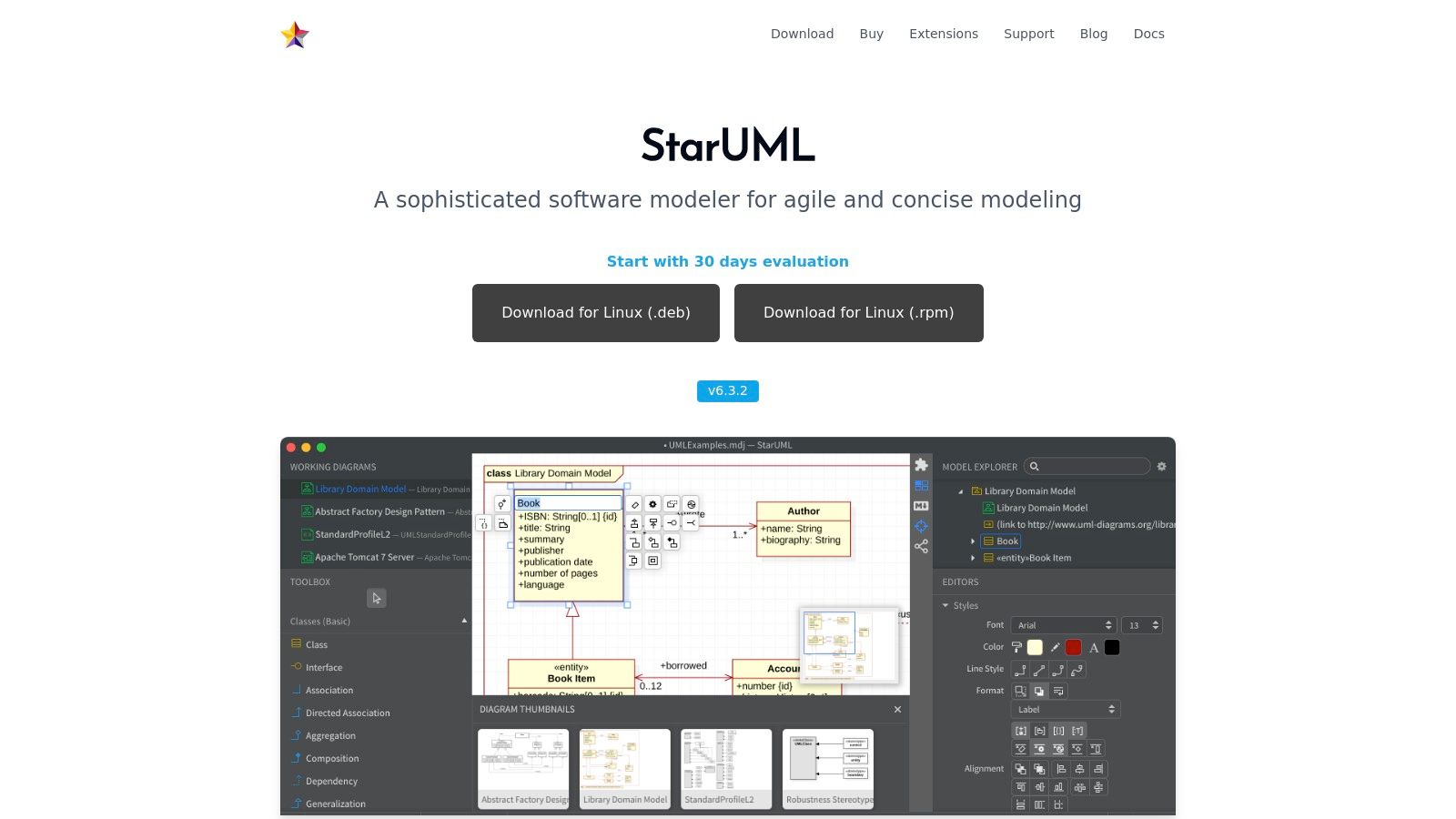
One of StarUML’s key strengths lies in its comprehensive support for UML 2.x, covering all standard diagram types including Class, Object, Use Case, Sequence, Communication, State Machine, Activity, Component, Deployment, and Package diagrams. This broad support allows developers to visually model all aspects of their software architecture, from high-level system design down to detailed class interactions. This is crucial for effectively communicating design intent, identifying potential issues early in the development lifecycle, and maintaining consistency throughout the project. For example, development teams working on a web application can utilize StarUML to create use case diagrams to capture user requirements, class diagrams to define the application’s structure, and sequence diagrams to illustrate the flow of interactions between different components.
StarUML shines with its code generation capabilities, supporting popular programming languages such as Java, C#, C++, and Python. This feature streamlines the development process by automatically generating code skeletons from UML diagrams, allowing developers to focus on implementing the core logic rather than writing boilerplate code. This not only saves time and effort but also ensures consistency between the design and implementation. For instance, a developer designing a data access layer can create a class diagram in StarUML and then generate the corresponding Java classes with the appropriate attributes and methods, significantly accelerating the initial development phase.
Beyond its core features, StarUML boasts an extension system that allows users to add further functionality through plugins. This extensibility allows for customization and adaptation to specific project needs. Users can find plugins for additional code generation targets, model validation, or integration with other development tools, expanding StarUML’s capabilities beyond its standard offering. This makes StarUML adaptable to a wide range of project requirements and development workflows.
While StarUML offers a wealth of features, it’s important to consider its limitations. Compared to some competitors, its collaboration features are less developed, making it less suitable for large distributed teams requiring real-time collaborative editing. Furthermore, the lack of a cloud or web-based version restricts accessibility and limits collaborative possibilities. While the software is generally stable, some users have reported occasional stability issues. The community supporting StarUML, while active, is smaller than those surrounding some open-source alternatives, potentially limiting the availability of readily available support and resources.
StarUML offers both free and commercial licenses. The free version, StarUML Community Edition, provides access to the core features and is suitable for individual users and students. The commercial license, StarUML Professional Edition, unlocks additional features such as code generation, export options, and technical support, making it a better fit for professional development teams. Specific pricing details are available on the StarUML website. Regarding technical requirements, StarUML is available for Windows, macOS, and Linux, ensuring compatibility across various development environments.
In comparison to other UML diagram software like Lucidchart or Draw.io, StarUML distinguishes itself through its focus on UML modeling and its robust code generation capabilities. Lucidchart and Draw.io offer broader diagramming capabilities, but their UML features might not be as comprehensive. StarUML’s strength lies in its dedicated UML focus, providing a powerful tool specifically tailored for software modeling. For users whose primary need is UML diagramming and code generation, StarUML provides a focused and powerful solution.
To get started with StarUML, download the appropriate version for your operating system from the official website (https://staruml.io). The intuitive interface makes it easy to create and manipulate diagrams, and the extensive documentation and tutorials provide ample guidance for new users. Exploring the available plugins can further enhance the software’s capabilities to suit specific project requirements. By leveraging StarUML’s features, developers can enhance their design process, improve communication within their teams, and streamline their development workflow.
Miro is a versatile online collaborative whiteboard platform that offers UML diagramming capabilities as part of its broader toolkit. While not solely a UML diagram software, its strength lies in facilitating team collaboration and visual brainstorming, making it a compelling option for agile teams seeking to integrate UML modeling with other collaborative activities. This makes it a valuable tool for software developers, engineers, tech startups, and other team-based development environments where visual communication and real-time collaboration are essential.

Miro provides an infinite collaborative whiteboard space equipped with a library of UML shapes, enabling teams to create various diagrams, including class diagrams, sequence diagrams, use case diagrams, and more. Its real-time collaboration feature allows unlimited team members to work on the same diagram simultaneously, fostering a dynamic and interactive design process. This real-time interaction is especially beneficial for remote teams or distributed development environments, promoting seamless communication and efficient workflow.
One of Miro’s key strengths lies in its robust integration ecosystem. It seamlessly integrates with popular development and project management tools like Jira, Confluence, Slack, and Microsoft Teams, further solidifying its place within agile workflows. This interoperability streamlines the development lifecycle by connecting UML diagrams directly to project tasks, documentation, and communication channels, thereby enhancing transparency and reducing context switching. For example, a team can create a user story in Jira and then directly link it to a use case diagram being developed in Miro. This connection ensures that all relevant parties have access to the latest designs and can contribute to the development process effectively.
Beyond its UML functionalities, Miro offers built-in video chat and presentation features. This facilitates real-time discussion and presentation of diagrams within the platform, eliminating the need for external communication tools. The extensive template library, including pre-built UML diagrams, further accelerates the diagramming process, providing a starting point for various modeling scenarios. This allows teams to quickly visualize complex systems and processes, facilitating better understanding and communication among team members.
For software developers, Miro offers a visually appealing and collaborative environment for designing software architecture, mapping user flows, and brainstorming system interactions. Web developers can leverage Miro’s UML capabilities to outline sitemaps, visualize database relationships, and plan API interactions. App developers can similarly utilize Miro to sketch out app functionalities, design user interfaces, and model data flows. DevOps teams can utilize Miro to visualize infrastructure diagrams, plan deployment strategies, and map system dependencies, further enhancing the collaborative nature of DevOps practices.
While Miro excels in collaboration and brainstorming, it’s crucial to acknowledge its limitations concerning advanced UML modeling. Compared to dedicated UML diagram software like Lucidchart or StarUML, Miro lacks advanced features such as code generation, model validation, and complex diagram customizations. This positions Miro more as a collaborative design tool with UML capabilities rather than a fully-fledged UML modeling platform. It’s best suited for teams prioritizing collaborative design and brainstorming over intricate UML modeling and code generation.
Miro offers a free plan with limited features and paid plans starting at $8 per user per month, scaling up for larger teams with additional features. Technical requirements are minimal, as Miro is a web-based platform accessible from any modern browser. Setting up Miro is straightforward, involving creating an account and inviting team members to the collaborative workspace.
In summary, Miro shines as a collaborative whiteboard platform that incorporates useful UML diagramming functionalities. Its strengths lie in its intuitive interface, robust collaboration features, and seamless integration with other development tools. However, it’s essential to recognize its limitations regarding advanced UML modeling capabilities. For teams prioritizing visual brainstorming, real-time collaboration, and integration within an agile environment, Miro offers a powerful solution. If the focus is on in-depth UML modeling, code generation, and model validation, dedicated UML tools might be a more suitable choice. Choosing between Miro and a specialized UML tool ultimately depends on the specific needs and priorities of the team.
Modelio stands out as a robust open-source UML diagram software, offering a compelling alternative to commercial solutions. It provides a comprehensive suite of tools for visual modeling, adhering to industry standards like UML, BPMN, and ArchiMate. This makes it a versatile choice for a wide range of users, from individual software developers sketching out initial designs to enterprise-level teams coordinating complex system architectures. Its open-source nature means that it’s freely available, eliminating licensing costs that can be prohibitive for smaller businesses, startups, or freelance developers. Moreover, the extensible architecture allows for customization through modules, adapting the tool to specific project needs and workflows. This combination of professional-grade features and cost-effectiveness makes Modelio a strong contender in the UML diagram software landscape.
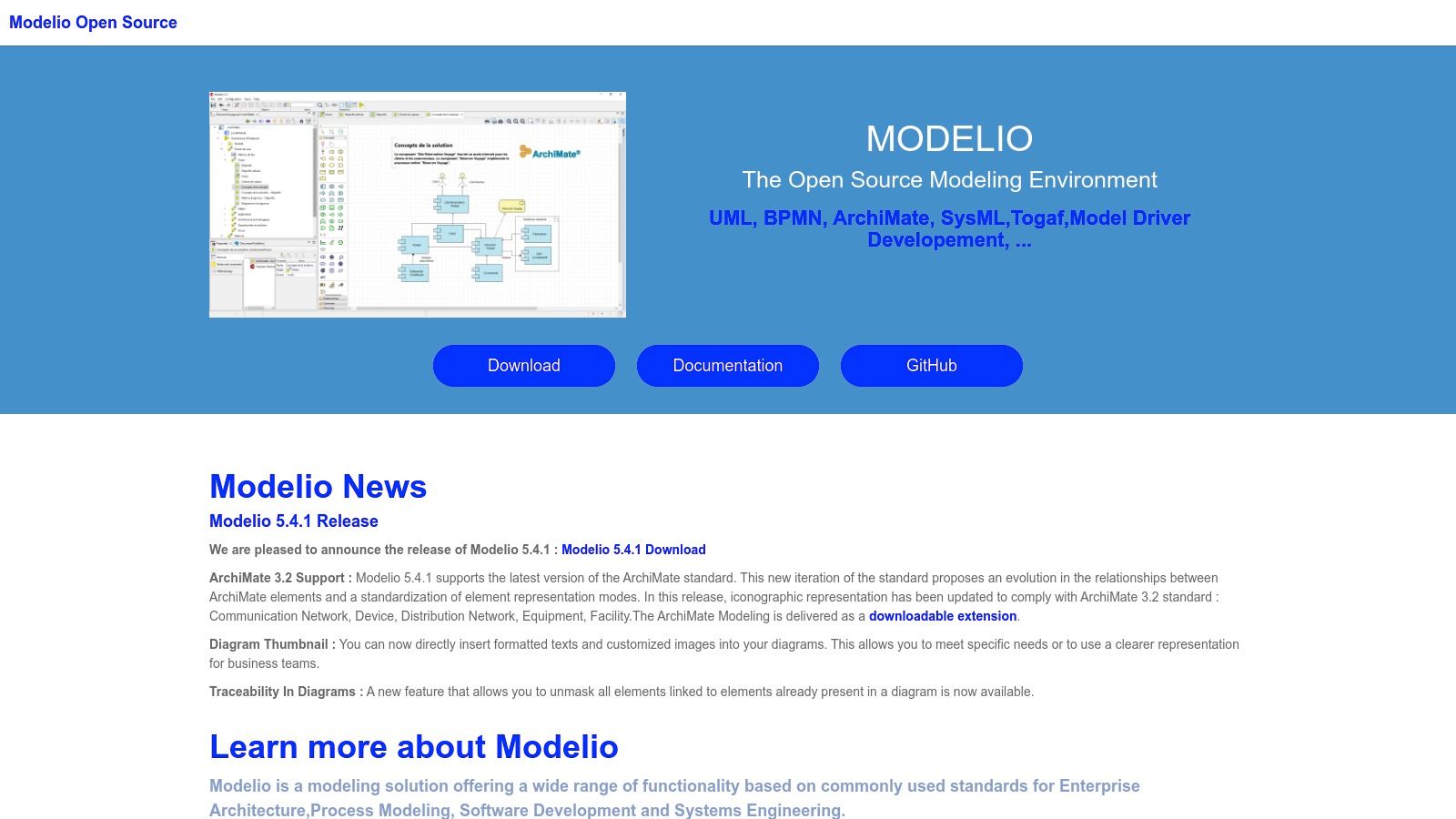
Modelio’s full support of UML 2.0 provides users with the necessary tools to create various diagram types, including class diagrams, sequence diagrams, use case diagrams, and state machine diagrams, covering the breadth of software design visualization needs. The added support for BPMN and ArchiMate broadens its application beyond software development, enabling business process modeling and enterprise architecture design. This is particularly beneficial for organizations seeking a single platform for different modeling tasks, enhancing consistency and collaboration across teams.
For practical applications, Modelio excels in several areas. Developers can utilize the code generation capabilities to automatically generate code skeletons from UML diagrams, saving time and reducing errors in the initial implementation phase. Conversely, the reverse engineering feature allows users to create UML diagrams from existing codebases, facilitating understanding and documentation of legacy systems or analyzing third-party code. This bi-directional code interaction streamlines the development process and improves the alignment between design and implementation.
Furthermore, Modelio’s module system provides extensibility for specific needs. Developers can leverage existing modules or create their own to tailor the software to unique project requirements or integrate with other tools in their development environment. This level of customization differentiates Modelio from many closed-source tools, providing flexibility for advanced users and specialized projects. The available documentation and active community forum also provide valuable resources for learning and troubleshooting.
While Modelio boasts a powerful set of features, it’s crucial to acknowledge its limitations. The interface, while functional, can appear dated compared to more modern UML tools. New users might experience a steeper learning curve due to the complexity of its functionalities, requiring some initial investment in training or exploration. The cloud collaboration features, although present, are not as sophisticated as some other online UML tools, potentially limiting seamless real-time collaboration for distributed teams. Furthermore, Modelio is primarily a desktop application, restricting access and collaborative editing options compared to web-based alternatives.
Compared to commercial tools like Enterprise Architect or Visual Paradigm, Modelio’s open-source nature and comprehensive feature set present a strong value proposition. While it may lack the polish and advanced collaborative features of these commercial counterparts, the absence of licensing fees makes it a highly attractive option for budget-conscious individuals and organizations. For those prioritizing cost-effectiveness without compromising on essential UML modeling capabilities, Modelio presents a compelling solution.
Setting up Modelio is straightforward, involving a typical software installation process. Users can download the appropriate version for their operating system from the official website (https://www.modelio.org). Upon installation, users can begin exploring the various features and creating UML diagrams. For beginners, the official documentation and community forum are excellent resources to get acquainted with the tool and its functionalities. Exploring the pre-built models and examples can also be a helpful way to understand its capabilities and best practices.